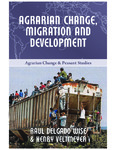
Please use this identifier to cite or link to this item:
http://ricaxcan.uaz.edu.mx/jspui/handle/20.500.11845/24| Title: | Agrarian change. Migration and development |
| Authors: | Delgado Wise, Raúl Veltmeyer, Henry |
| Issue Date: | 2016 |
| Publisher: | Fernwood Publishing |
| Abstract: | Between 1970 and 2012 the number of international migrants worldwide more than doubled, from 84 million to 232 million. In 1970, about one out of every 29 people lived in a country where international migrants composed a tenth or more of the total population. Four decades later, the ratio was nearly one in nine (Terrazas 2011: 1). Much of this growth took the form of mass migration from poor countries in the global south, on the periphery of the world capitalist system, to the wealthier countries in the global north. While in earlier periods of capitalist development people also migrated for economic reasons, motivated by a desire for a beter life and a search for more opportunity, the largest flow of migrant labour was from the European centre of world capitalism to European “white” setlements in the North American outposts of the British Empire. But in the current conjuncture of capitalist development (the neoliberal era), most migration is in a south-north/south-south direction. Within the migrant-receiving countries in the north, these migrants generally setle in the larger cities, urban gateways to an apparently modern style of life and hoped-for economic opportunity. |
| URI: | http://hdl.handle.net/20.500.11845/24 |
| Other Identifiers: | info:eu-repo/semantics/publishedVersion |
| Appears in Collections: | *Documentos Académicos*-- UA Estudios del Desarrollo |
Files in This Item:
| File | Description | Size | Format | |
|---|---|---|---|---|
| Agrarian Change, Migration and Development.pdf | Libro Completo | 1,46 MB | Adobe PDF |  View/Open |
This item is licensed under a Creative Commons License
